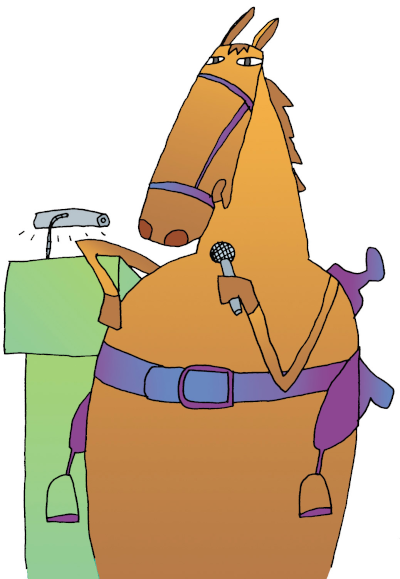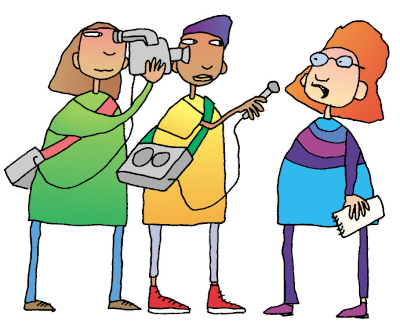
Page 365
Giving Speeches
“Hey, I’d like to learn how to saddle a horse. Do you think you could show me?”
If this request came from a friend and you were really good at saddling a horse, you’d probably say, “Sure!”
But if you’ve never saddled a horse in your life, and the request came from a roomful of old-west bandits, well, that’s a different story.
This chapter helps you give great speeches—to one or many:
- Tip 1: When you give a speech, choose a topic you love.
- Tip 2: Know your audience.
- Tip 3: Avoid giving speeches to old-west bandits.
What’s Ahead
WE 366
Page 366
The Steps in the Process
Whenever you are asked to prepare a speech, follow these nine steps, and you’ll do just fine.
1. Decide which kind of speech you will give.
First, ask yourself, “Why am I giving this speech?” Is it to share information, to demonstrate something, or to change people’s minds?
Speech to Inform

An informational speech gives interesting or important facts and details about a topic. You might inform your audience, for example, about a new discovery that uses recycled plastic to make roads hold up better in harsh winter climates.
Speech to Demonstrate
A demonstration speech shows how to do something. You might show your audience how to wash a car or how to make peanut-butter fudge.
Tip You will want to use visual aids with your demonstration speeches.
Speech to Persuade
A persuasive speech tries to convince listeners to agree with your opinion about a topic. You might try to persuade your audience that there should be a law that all school buses must have seat belts.
WE 367
Page 367
2. Pick your topic carefully.
Once you know what kind of speech you’ll be giving, you need to choose an appropriate topic. Ask yourself these questions:
- What do I know a lot about?
- What would I like to know more about?
- What do I enjoy doing?
- What do I like to read about?
- What do I talk about with my friends?
(See “Selecting and Collecting” on pages 35–44 for more help.)
3. Narrow your topic.
Let’s say that because you love horses, you’ve chosen “horses” as the general subject of your speech. Next, you need to narrow your subject to a specific topic that’s just right for the speech. Here are some examples:
Speech to Inform
For an informational speech, you could describe how to take care of a horse, or you could talk about different kinds of horses.
Speech to Demonstrate
For a demonstration speech, you could show your audience how to saddle and bridle a horse, or you could show them how to braid a horse’s mane for a horse show.
Speech to Persuade
For a persuasive speech, you could try to convince your listeners that anyone can enjoy horseback riding, even if you don’t own a horse.
Note Consider your audience when you choose a subject, just as you consider your guests when you plan a party. If you invited grandparents, would you play Kidz Bop? If you invited your friends, would you play waltzes?
WE 368
Page 368
4. Gather information.

Begin gathering information for your speech by looking through books and checking out articles on the Internet. Then look further.
- Observe and take notes on people, places, and events around you.
- Talk or write to experts in your school, family, or neighborhood.
- Watch videos, visit Web sites, and read articles.
- Recall past experiences.
Note Remember to use drawings, photos, props, or video clips during a demonstration speech.
5. Prepare an exciting introduction.
After you’ve gathered enough information, write the beginning of your speech. Here are some good ways to begin:
- Use a famous quotation.
“. . . forbid that I should go to a heaven in which there are no horses.”—Theodore Roosevelt
- Tell a story.
One day two summers ago, I was riding my horse in the field near our house when suddenly . . .
- Refer to a recent incident.
At the last Olympics, the U.S. equestrian team continued racking up medals, the most decorated team in the sport.
- Make a striking statement.
Horses understand body language better than people do. The slightest twitch of your body can tell a horse to move.
- Ask an interesting question.
Did you know that horses have a language of their own?
WE 369
Page 369
6. Write an outline.
After writing your introduction, construct an outline of your speech either on note cards or on paper. Use short phrases—just enough words to remind you of what you want to say. It’s a good idea, however, to write out your introduction and conclusion word for word. And don’t forget to add reminders (in parentheses) about using pictures or props.
Sample Note Cards

WE 370
Page 370
7. Write your speech.
You may give your speech using your outline, or you may write out your speech word for word. If you decide to write out your speech, review “Steps in the Writing Process” on pages 10–12 and then do the following:
- Keep your purpose (to inform, to demonstrate, to persuade) in mind and also remember who your audience is.
- Include specific details: examples, stories, facts, and figures.
- Choose the best words and arrange your thoughts and details into clear, interesting sentences.
- Use transitions to tie everything together.
8. Practice your delivery.
Practice your speech on at least two different days. You’ve heard that practice makes perfect: That is especially true when it comes to giving a speech. Do one or more of the following:
- Practice in a quiet place where you can listen to yourself.
- Practice in front of friends or parents. Ask for their suggestions.
- If possible, record yourself. Play it back and watch and listen to see how you can improve your speech.
- Review the points in step 9 below and keep them in mind as you practice.

9. Present your speech.
When you are ready to give your speech, remember these points:
- Look at your audience.
- Stand up tall; don’t slump, sway, or lean.
- Speak loudly—use your “outside” voice.
- Speak clearly; don’t mumble or use expressions like ah or um.
- Speak slowly and don’t rush.
WE 371
Page 371
Sample Speech
If you follow the steps in the process, you should end up with a speech that is interesting to your listeners. (Add reminders so you don’t forget to use your props.)
Saddle Up!
The average horse weighs between 1,000 and 1,600 pounds. When you consider that I weigh just a small fraction of that, it seems amazing that I can climb onto a horse and get him to take me where I want to go. One thing that helps me is knowing the personality of my horse, but I also depend on my equipment: a saddle, saddle pad, bridle, bit, and reins.
The first step is to prepare the horse for the saddle. I talk to my horse, rub under his mane, and stroke his neck to help him relax. I always stand on the left side of my horse as I place the saddle pad just below his withers, which is the ridge between his shoulders. (Show visuals.)
Next I place the saddle on top of the pad. From the right side, I check and straighten the girth, the strap that fastens the saddle on the horse. Then I tighten the girth from the left side. Just before I mount, I will tighten it a final time. (Show visuals.)
Now I’m ready for the bridle, bit, and reins. They are all connected. (Show props.) I hold the bridle from the top with my right hand with my arm resting over my horse’s head. Then I guide the bit into the horse’s mouth with my left hand. Next I pull the bridle up over his ears and buckle it under his throat. I make sure his mane is not caught under the bridle. That would hurt, just like it hurts when something pulls your hair.
All I have to do then is collect the reins. That just means that one rein is on each side of the horse’s neck, and the ends are in my hand. After I mount, I’m ready to ride.
WE 372
Page 372
Evaluating a Speech
Use the following checklist to prepare and evaluate your speeches. You can also use this checklist to evaluate the speeches of others.